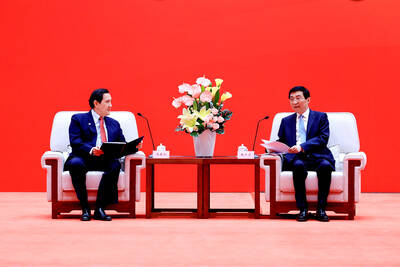Twitter Inc now speaks more Japanese — and it plans to be multilingual within months.
The popular microblogging service launched a Japan-based mobile version on Thursday, hoping to penetrate a country where other US social networking sites including Facebook and MySpace have failed to capture much ground.
Japanese is Twitter’s sole non-English platform so far, and the company’s efforts here indicate it’s serious about making it big in Japan — and eventually all over the world.
Twitter teamed up with Tokyo-based Internet firm Digital Garage Inc early last year. It launched a Japanese-language platform for PCs in the spring of last year, and hired a Japan country manager earlier this year.
“It’s an excellent opportunity for us to see where we can go in Asia in general because Japan represents a leading edge, with advanced mobile usage,” said Twitter co-founder Biz Stone, who traveled to Tokyo for the launch. “Mobile is in Twitter’s DNA.”
The company will roll out the site in Spanish, German, French and Italian over the next few months, Stone added.
The San Francisco-based company is also using Japan to experiment with ways to make money from features unavailable on its English language site, such as banner ads. It remains mum on how much revenue the ads have attracted so far.
Early adopters were largely male tech geeks, but the messaging service is finally gaining some traction in mainstream Japan.
Between January and June, the number of users jumped almost fourfold to 783,000, according to Internet research firm NetRatings.
Japanese celebrities and politicians are starting to sign up. So are traditional media outlets like newspapers and radio stations as well as municipalities and companies eager to take advantage of Twitter’s marketing potential.
Lawmaker Kenzo Fujisue first heard about Twitter from a friend in Silicon Valley and now tweets regularly throughout the day. He has more than 5,400 followers, and his 140-character messages — all in Japanese — range from serious policy issues to the more mundane, like what he ate for dinner.
“People don’t really know what politicians do,” he said. “Twitter helps me give people a glimpse of the lawmaking process.”
Still, Twitter remains a mystery to the vast majority of Japanese Web users. Mixi, the country’s top social networking site, has 17 million users and is aiming for 30 million within four years.
The key to expansion in Japan is to develop a locally friendly mobile platform, Digital Garage’s Rocky Eda said in June.

LONG FLIGHT: The jets would be flown by US pilots, with Taiwanese copilots in the two-seat F-16D variant to help familiarize them with the aircraft, the source said The US is expected to fly 10 Lockheed Martin F-16C/D Block 70/72 jets to Taiwan over the coming months to fulfill a long-awaited order of 66 aircraft, a defense official said yesterday. Word that the first batch of the jets would be delivered soon was welcome news to Taiwan, which has become concerned about delays in the delivery of US arms amid rising military tensions with China. Speaking on condition of anonymity, the official said the initial tranche of the nation’s F-16s are rolling off assembly lines in the US and would be flown under their own power to Taiwan by way

CHIP WAR: The new restrictions are expected to cut off China’s access to Taiwan’s technologies, materials and equipment essential to building AI semiconductors Taiwan has blacklisted Huawei Technologies Co (華為) and Semiconductor Manufacturing International Corp (SMIC, 中芯), dealing another major blow to the two companies spearheading China’s efforts to develop cutting-edge artificial intelligence (AI) chip technologies. The Ministry of Economic Affairs’ International Trade Administration has included Huawei, SMIC and several of their subsidiaries in an update of its so-called strategic high-tech commodities entity list, the latest version on its Web site showed on Saturday. It did not publicly announce the change. Other entities on the list include organizations such as the Taliban and al-Qaeda, as well as companies in China, Iran and elsewhere. Local companies need

CRITICISM: It is generally accepted that the Straits Forum is a CCP ‘united front’ platform, and anyone attending should maintain Taiwan’s dignity, the council said The Mainland Affairs Council (MAC) yesterday said it deeply regrets that former president Ma Ying-jeou (馬英九) echoed the Chinese Communist Party’s (CCP) “one China” principle and “united front” tactics by telling the Straits Forum that Taiwanese yearn for both sides of the Taiwan Strait to move toward “peace” and “integration.” The 17th annual Straits Forum yesterday opened in Xiamen, China, and while the Chinese Nationalist Party’s (KMT) local government heads were absent for the first time in 17 years, Ma attended the forum as “former KMT chairperson” and met with Chinese People’s Political Consultative Conference Chairman Wang Huning (王滬寧). Wang

OBJECTS AT SEA: Satellites with synthetic-aperture radar could aid in the detection of small Chinese boats attempting to illegally enter Taiwan, the space agency head said Taiwan aims to send the nation’s first low Earth orbit (LEO) satellite into space in 2027, while the first Formosat-8 and Formosat-9 spacecraft are to be launched in October and 2028 respectively, the National Science and Technology Council said yesterday. The council laid out its space development plan in a report reviewed by members of the legislature’s Education and Culture Committee. Six LEO satellites would be produced in the initial phase, with the first one, the B5G-1A, scheduled to be launched in 2027, the council said in the report. Regarding the second satellite, the B5G-1B, the government plans to work with private contractors